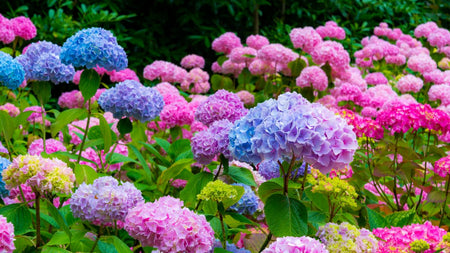
Images Depict Mature Plants
Climbing Hydrangea for Sale Online
The Climbing Hydrangea (Hydrangea anomala petiolaris) is a unique departure from the standard hydrangea. Plant this vining specimen in your yard this spring to enjoy fragrant large white flower clusters in May through June.
The enchanting lace cap flowers are surrounded by heart-shaped, dark green foliage that makes the Climbing Hydrangea's color pop. No trellis is needed to grow these flowering vines for the Climbing Hydrangea vine grows effortlessly without help or support. The vines even have the ability to cling to a concrete wall or tree using their aerial roots.
The Climbing Hydrangea vine flourishes in moist, well-drained soils that are acidic. However, this resilient plant will tolerate dryer conditions as well. Growing Climbing Hydrangea plants is incredibly low maintenance and very worth the beauty it brings to a yard.
Ideal conditions for the Anomala Hydrangea includes full shade and a well draining soil medium. However, these hardy yard shrubs can also tolerate partial shade, afternoon shade and full sun in cooler climates. This shade-loving plant can be slow to establish, but don’t let it fool you. Once a root system is developed, vigorous climbing begins, and it can cover your trellis or wall in no time.
In the fall, this deciduous plant thins, revealing the reddish-brown stems beneath. The bare stem form allows sun to shine through and makes for a stunning winter interest shrub. Or, if you so desire, you could train your Climbing Hydrangea to grow horizontal to become an extraordinary ground cover. The unique early summer blooms of these plants also make for a stunning drying flower bouquet.

| Hardiness Zone: | 5-9 |
|---|---|
| Mature Width: | 60 to 80 Feet (If left to grow) |
| Mature Height: | 60 to 80 Feet (If left to grow) |
| Classification: | Vine style hydrangea |
| Sunlight: | Full sun to part shade |
| Habit: | Climbing; vine-like |
| Flower Color: | Pure white blooms early summer to early fall |
| Foliage: | Dark green |
| Pruning Season: | Late winter to early spring, promotes increased branching and more flowers. Flowers on new growth |
| Soil Condition: | Any well drained soil |
| Water Require: | Water well until established |
| Uses: | Extremely attractive when used as a privacy shrub when paired with a trellis |
How to Care for Climbing Hydrangea
Be sure to read our planting instructions to ensure a healthy and happy plant for years to come!
How should I plant my Climbing Hydrangea Vines?
Place your newly purchased Climbing Hydrangea into a hole that is twice as wide as its roots, but no deeper. It is best to start this process in early summer. After covering with well-draining soil and organic matter, wall your plant generously. If you want to double up, space the plants 4 feet apart. As I mentioned earlier, it takes time for the roots to establish, so it may be a while before you see the first bloom; patience is key. Apply around the roots to block pesty weeds and retain moisture.
What kind of fertilizer do I use for my Hydrangea Vine?
Unlike some of its cousins, this hydrangea is nearly pest and disease-free. The only potential issue that may arise can be traced to a soil that is not acidic enough. In order to prevent this, it is recommended to fertilize your vine's roots with Espoma Soil Acidifier. In addition, adding organic matter, such as compost, to the root zone will provide much-needed nutrients to the hydrangea.
How do I water my Climbing Hydrangea?
Water at least weekly, or more often in order to maintain the moist soil your Climbing Hydrangea desires. To test the ground's moisture, stick your finger 2 inches into the ground. If it is getting dry, water your vine that day, but skip if it is already moist.

How do I prune my Climbing Hydrangea Vine?
This vine can grow up to 80 feet tall and wide if left unattended. If this size is not ideal you can train it to be smaller with pruning and trimming. In addition, the blooms grow on old wood, so prune once the blooms fall away in the summer. Pruning in the spring will deter the fragrant blooms from forming.



















